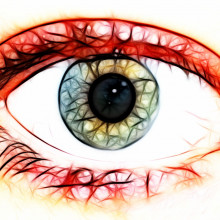How does an object in front of you turn into an image in your brain? Adam Murphy brings us the details...
In this episode

Naked Body: The eyes have it
Adam Murphy, The Naked Scientists
How does an object in front of you turn into an image in your brain? Adam Murphy brings us the details...
The eye is a wonderfully complex thing, some estimates say up to a third of the average human brain is devoted just to processing the information that comes in. And just like a camera is a collection of complex parts all working in harmony, so is the human eye.
The cornea is at the very front. It’s a curved piece of tissue that serves to protect the rest of the eye, and to help focus the incoming light through your pupil, so you can see things clearly.
Because really that’s what your eye is, a fleshy camera.
Behind the cornea is the iris, the pretty, colouredy bit. The iris is the aperture for your eye. It controls how much light goes in through your pupil. Muscles all around can contract the iris and change the shape of the pupil, contracting if there’s too much light, or widening if there’s not enough so it can take in all the light it can when it’s darker.
Behind the iris is the lens. The lens works with the cornea to focus light onto the back of your eye. Although the lens doesn’t bend light as much as the cornea, it can change shape and focus light differently depending on how far away the object is.
Your lens also cuts down on the amount of ultraviolet light you can see. In his later years the painter Claude Monet had one of his lenses removed, letting in more ultraviolet light, as so his late paintings all have a purple hue to them.
If you’re short-sighted, or myopic, your eye focuses light to a point before it hits the retina. Maybe your eyeball is elongated like a rugby ball, instead of round like a football. So to correct this, you might wear glasses that diverge the light a bit before they reach your cornea.
At the back of the eye you’ll find the retina. I mean, it’s there, don’t go looking, you’ll poke yourself in the eye.
The retina consists of layers of modified neurons, nerve cells, arranged across the back of your eye. Since you can see the retina with a decent camera, it’s the only part of the nervous system that can be visualised directly without having to go inside the subject. Which is nice.
The retina does the job of detecting the light that falls on the back of the eye and turning it into electrical signals the brain can understand, and there are two main types of cell that help with that, rods and cones.
Rods are well…rod shaped, are very sensitive to light and are very densely packed in the eye. In fact, there are 100 million of them in each of your eyes. But rods don’t play much of role in colour vision. They do play a big role in helping you see when it’s dark.
When light hits a rod cell, it causes a chemical, rhodopsin, that’s contained within the rod cells to change shape. When it does that, the rod sends signals to the brain that say: “hey, there’s light here.”
Cone cells are shaped like elephants….I’m kidding, they’re cones. and they are larger than rods. There are also far fewer of them: you only have have 7 million cones in each eye, and most of them are concentrated in one region of the retina called the “macula”, which is the part that produces the sharpest vision.
Cone cells aren’t as sensitive as rod cells, but they let you see colour. Most people have three different kinds of cone cells covering the retina.
They work in the same way as rod cells, but their shape changing chemicals are only sensitive to red, green, or blue light.
You see red when only the red cones are activated. You see blue when the blue cones are stimulated, and you see yellow when the red and green cones are stimulated.
Now there’s light on the back of the retina, how does the brain turn that into an image. Well, your brain gets its wires crossed. But in a good way.
Behind your eyes, the optic nerves, which takes signals from the retina to the brain cross paths. There they split, and the bundle of nerve fibres for the left side of each retina goes to the left side of the brain, and the same for the right side.
The brain then knows what’s on the left side of each eye, what’s on the right side, and what’s in the middle, which is probably what you’re looking at in the first place, and so it can combine that into an image.
This all happens in the visual cortex, a section at the very back of your brain. So everything in front of your nose is processed in the back of your head. Which is a bit strange.
But our two eyes have allowed humanity to be the best pupils of the world around us. So take care of them, try not to poke them too often, and enjoy what they have to show us.
Related Content
- Previous Monkey Island Discs: Ben Rich
- Next Can dogs detect Covid-19?










Comments
Add a comment